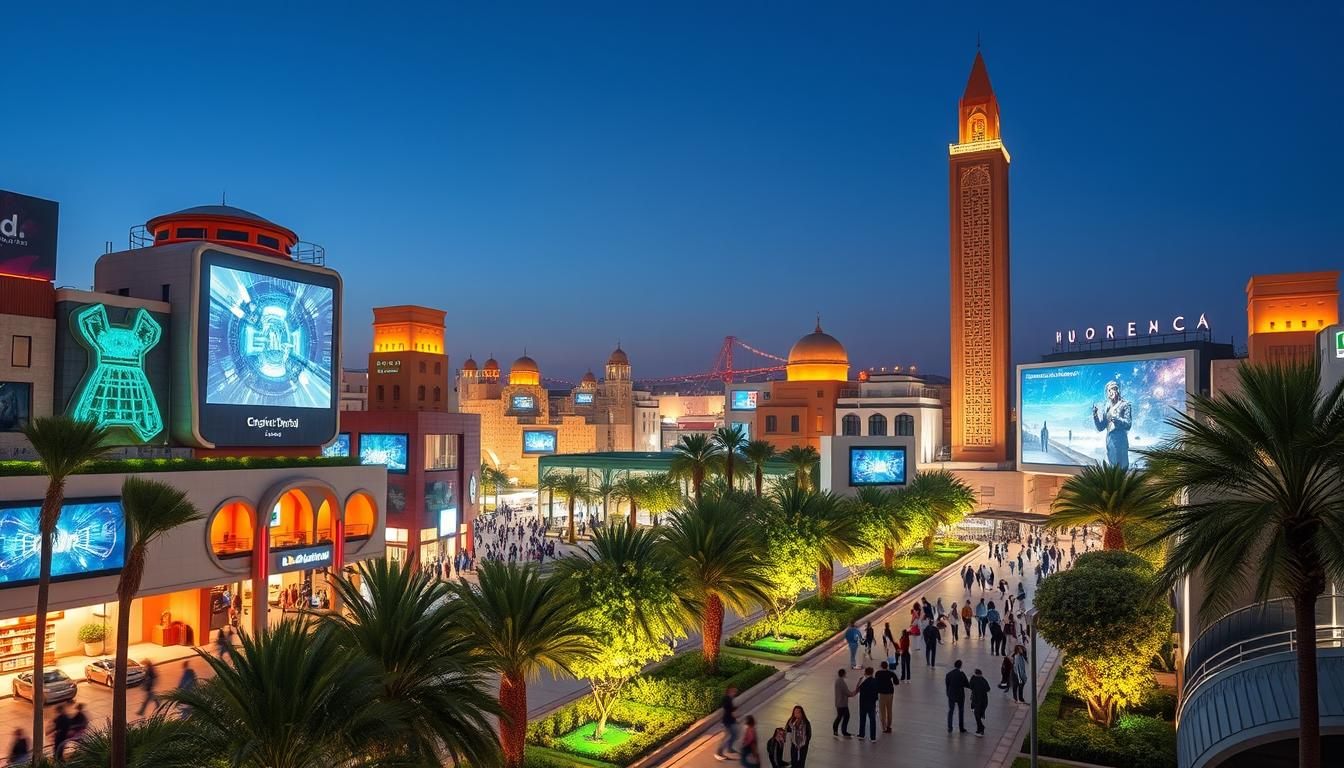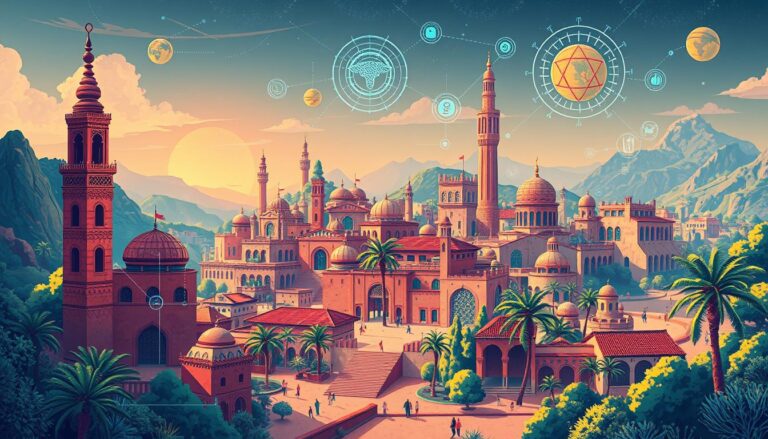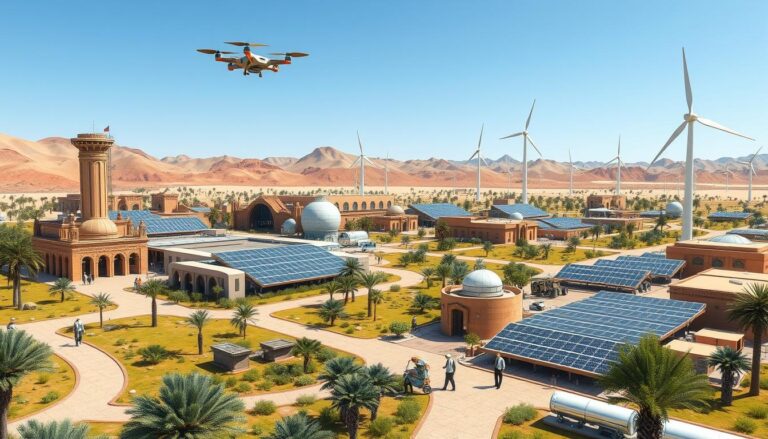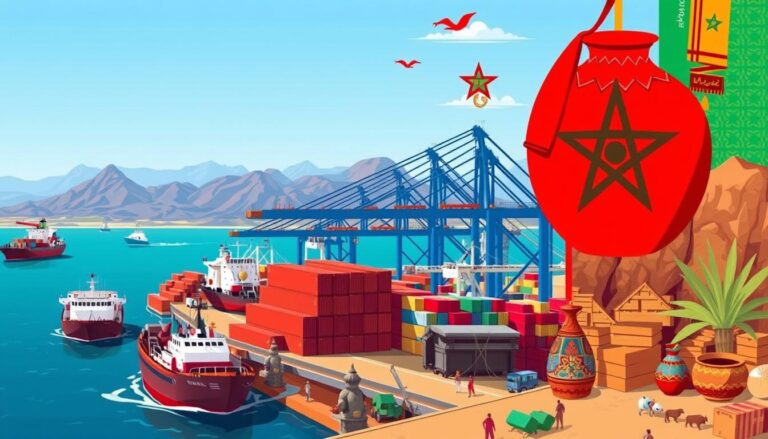What does it take for a country to become a digital leader in North Africa? Morocco is making a big push towards becoming a digital hub. The government is focusing on technology and building new infrastructure.
The National Digital Development Strategy 2020-2025 is driving Morocco’s digital growth. It aims to create a digital environment that supports everyone and encourages new ideas. Projects like E-GOV and DigiTPME, backed by the BMZ, help public services and small businesses go digital.
Morocco wants to be a digital leader in the region by 2030. It has big plans, like making over 2,700 government services digital. The goal is to have 93% of people online and get $500 million from the World Bank for digital projects. The Digital Development Agency (ADD) and training centers like the 1337 in Khouribga are key to achieving these goals.
A Brief Overview of Digital Transformation in Morocco
Morocco’s journey into digital transformation is both interesting and complex. It shows the country’s dedication to using technology for growth. Key strategies have focused on making public services digital and improving digital skills.
Programs like e-Morocco 2010, Digital Morocco 2013, and Digital Morocco 2020 have driven progress.
Government Initiatives and Strategies
The government has been crucial in Morocco’s growth. A high-level AI forum in Rabat in June 2024 highlighted AI’s role in development. The Digital Development Agency (ADD) and UNESCO also studied setting up an AI Center in Morocco.
These efforts show Morocco’s commitment to digital technologies adoption.
Key Milestones and Achievements
Morocco has reached important digital milestones. Working with Smart Africa, GIZ, and other countries has been key. These partnerships helped create data strategies and secure data infrastructures.
Morocco also focuses on digital education and training. Chari’s work with 60 women at their call center is an example. The country’s work in agricultural innovation also shows its potential for growth through technology.
These achievements show Morocco is not just adopting digital technologies. It’s building a system that supports growth that’s sustainable and inclusive.
The Role of the Digital Development Agency (ADD)
The Digital Development Agency (ADD) was set up in 2015 by Morocco’s government. It plays a big role in the country’s digital plans. ADD helps mix digital tech into different parts of the economy and boosts the digital world.
ADD works hard to help Morocco go digital. It teams up with telecoms, internet providers, and others to make sure everyone has access to digital services. For example, there’s a plan to bring fast internet to every family in Morocco.
ADD focuses on making the digital world better. It uses satellite and wireless tech in places where fiber isn’t possible. It also creates digital solutions for areas like tourism, farming, health, and education.
ADD has big partnerships to help Morocco’s digital scene. It works with The Hashgraph Association and UM6P Ventures to use AI, IoT, and Quantum tech. These partnerships aim to use deep tech for growth and better lives.
ADD also works on making people better at using digital tools. It offers classes and training for students, teachers, government workers, and business owners. The goal is to make digital tech a big part of education and train 100,000 young people every year from 2024 to 2026.
ADD also helps small businesses and startups. It gives them support and money to grow their digital presence. By improving the digital world and making sure everyone can use it, ADD helps Morocco create 130,000 jobs and add 100 billion dirhams to its economy by 2030.
National Digital Development Strategy 2020-2025
Morocco has a plan for digital growth from 2020 to 2025. It aims to improve digital infrastructure, innovation, and e-government services. The goal is to make Morocco a digital leader with clear steps to follow.
Goals and Objectives
The Digital Morocco Plan started in 2009 and set big goals. It made 50% of public services online by 2020. Now, the Maroc Digital 2020-2025 plan wants to improve life through digital means.
It focuses on three main areas:
- Digital Management
- Innovation
- Combating Social Exclusion while fostering human development
The plan also aims to digitize all administrative tasks by 2030. It wants to connect 100% of important structures to public services online. Morocco aims to be among the top three in digital services in the Middle East and Africa.
Implementation and Progress
The National Digital Development Strategy has seen great progress. The Digital Morocco Plan launched 377 websites and 547 public services online by 2012. It also increased access to administrative procedures by 18%.
The open government plan from 2018 to 2020 saw an 84% success rate. It improved public data access, budget transparency, and set up new administrative facilities. Morocco’s digital ranking has also improved, from 82 in 2014 to 110 in 2018, and then up four places in 2020.
The COVID-19 pandemic has shown how important digital tools are for work. This has sped up Morocco’s digital progress.
But, there are still challenges to meet Morocco’s digital goals by 2025. More work is needed in digital skills and governance to achieve these goals.
Digital Infrastructure Development
Morocco’s digital world is growing fast, thanks to strong efforts in tech. The data centre market is expected to hit US$51.0 million by 2028. This shows Morocco’s dedication to its digital future.
African Infrastructure Investment Managers (AIIM) just put US$90 million into a new project. This is a big step towards better IT in Morocco. Oracle is also building two new data centres to help with digital growth.
More people in Morocco have internet, with a rate of 90.7%. The government is making it easier for businesses to grow. This is great for the data centre industry.
The National Energy and Energy Efficiency Plan (NEEAP) was launched in 2008. It aims to cut carbon emissions and bring more electricity to rural areas. This plan fits well with Morocco’s goal for a green digital economy.
Morocco is investing 11 billion dirhams ($1.14 billion) in digital jobs from 2024 to 2026. The goal is to train 100,000 young people in digital fields each year. By 2030, Morocco wants to create 240,000 jobs in the digital sector.
In summary, Morocco is working hard to improve its tech and digital economy. This will help the country grow economically and advance technologically.
The Emergence of Smart Cities
Morocco is at the forefront of urban digital transformation. It aims to turn six cities into smart cities by 2026. The journey started in Casablanca in 2016 and will include Marrakech, Rabat, Tangier, Ifrane, and Fez. This shows Morocco’s dedication to using technology for urban growth.
Projects and Collaborations
The development of smart cities in Morocco focuses on international partnerships and urban projects. A key example is the USTDA-sponsored visit of Moroccan officials to the United States. This highlights the importance of global collaboration.
These partnerships aim to boost digital access and improve government services. They do this by integrating IT and digitalizing project management.
Smart city projects in Morocco are based on six key areas:
- Smart Economy
- Smart Mobility
- Smart Environment
- Smart Life
- Smart People
- Smart Governance
Impact on Urbanization
The digital transformation in Morocco is changing how cities work. It involves big changes in urban infrastructure, affecting citizens’ daily lives. Smart cities aim to improve public services through technology.
Smart cities in Morocco focus on human and social capital, transport systems, ICT, energy, and sustainable development. They also aim for a high quality of life and efficient use of natural resources. This shows the benefits of smart urban planning.
The success of smart cities depends on people using new technologies. It promotes creative human capital as a key part of smart city development.
Boosting Digital Skills in Morocco
Improving digital skills in Morocco is key to its growth. The country is working hard to boost digital literacy. It’s doing this through better education and training, and by teaming up with private companies.
Education and Training Programs
Morocco is making big steps in digital literacy. The “Connected Classrooms” program will help schools near LafargeHolcim Morocco sites for three years. Also, twelve universities are starting 144 new digital programs to update education.
By 2025, they aim to improve the digital skills of 10,000 literacy teachers. This will help shape a modern education system.
Public-Private Partnerships
Working with big tech companies and local businesses is helping Morocco’s digital skills. Huawei’s Seeds for the Future program has helped 2.8 million people worldwide. It wants to help even more.
LafargeHolcim Morocco plans to train 22,500 digital experts by 2027. This shows how well public and private groups can work together. Their efforts are making vocational training better and aligning with Morocco’s digital goals.
Supporting Startups and SMEs
Morocco is dedicated to helping startups and SMEs grow, especially in going digital. They work hard to meet both national and international goals. Helping Moroccan SMEs go digital is key for the country’s economic growth.
Funding and Resources
The Moroccan government plans to spend 11 billion MAD from 2024 to 2026 on digital projects. They aim to create 240,000 jobs in the digital field. The UNWTO and the Moroccan Ministry of Tourism are starting a project to help 10,000 small businesses go digital.
They also want to start a National Startup Competition to encourage new ideas in tourism. The goal is to create 3,000 startups by 2030 and raise 7 billion MAD. The Digital Talents Initiative will train 100,000 young people every year by 2027. This will help Moroccan SMEs become more digital.
Success Stories
There are many success stories in North Africa’s startup world. Tech companies have grown thanks to government support. They are now important in the digital economy.
These stories show Morocco’s smart way to boost small and medium businesses. It helps them grow, increase exports, and create jobs.
International Collaborations and Partnerships
Morocco is a key player in global tech partnerships. It has a strong partnership with AfriLabs, which has over 450 tech hubs in 53 African countries. This partnership, backed by UM6P Ventures, aims to boost the African startup scene and create new opportunities for Morocco.
The collaboration between AfriLabs and UM6P Ventures is set to last for one year, leveraging UM6P’s infrastructure, expertise, and talent.
AfriLabs Connect Deal Room (ACDR) will help UM6P Ventures find startups to invest in. UM6P Ventures supports startups in various fields like Agriculture and Healthtech. This shows Morocco’s commitment to global tech collaboration.
UM6P Ventures also focuses on improving education. Recently, 152 experts were trained in Augmented, Virtual, and Mixed Reality. This shows Morocco’s skill in advanced technology.
Over 797 professionals have also improved their skills. More than 240 professors were trained in AVR technology. This helps them innovate in their teaching.
XR modules are now part of bachelor’s and master’s degrees at Mohammed VI Polytechnic University. This move shows Morocco’s dedication to using modern tech in education. The project costs $28,951,500, with USAID contributing $3 million.
The project is based at Mohammed VI Polytechnic University in Ben Guerir. It will run from 2019 to 2024. This will lay a strong foundation for Morocco’s digital future.
Morocco is becoming a leader in global tech partnerships. It shows Morocco’s ability to innovate and succeed internationally. With a focus on digital partnerships, Morocco aims to grow in various tech fields.
Challenges and Opportunities in Digital Innovation
Morocco is making progress in digital innovation, but it faces challenges and opportunities. These issues need strategic planning and commitment from all parties.
Cybersecurity and Data Protection
Digital technology advances quickly, posing risks to Morocco’s digital security. Cyber attacks and data breaches can harm both public and private sectors. Morocco is taking these threats seriously and investing in cybersecurity.
The country has started programs to improve data protection, like the National Commission for the Control of Personal Data Protection (CNDP). The rise in internet users from 19% in 2016 to 36% in 2021 shows the need for strong cybersecurity. Morocco is working to reduce cyber-vulnerability and create a legal framework for digital security.
Future Prospects
The future for Morocco’s digital growth and investment looks bright. Digital technologies can boost socio-economic development, as seen in Sub-Saharan Africa. There, internet users have increased by 115% in five years.
Morocco is focusing on digital skills through projects like e-TAMKEEN and innovation initiatives like IDARATHON. This shows a commitment to a digitally skilled workforce. As seen in Nigeria and Tanzania, internet access can reduce poverty and create jobs. This shows Morocco’s potential for economic and social growth.
Investing in digital security and innovation in Morocco is key. It can lead to a secure and strong digital ecosystem. This will ensure sustainable development and prosperity for everyone involved.
How Digital Innovation in Morocco is Shaping the Future
Morocco is quickly becoming a major player in African tech. It’s doing this by building a strong innovation ecosystem in Morocco. This is setting the stage for a bright digital future.
From 2023 to 2026, Morocco plans to boost research and development. It wants to help startups grow and reach markets worldwide. The goal is to see a ‘unicorn’ company in Morocco, a big step in its digital goals.
The Technopark infrastructure is being improved to support new startups. This place is key for innovation. It’s at the heart of Morocco’s digital world.
Morocco is also linking its IT professionals with Belgian projects. This shows Morocco’s global vision. It’s all about startups and shaping digital futures.
The business world is changing fast. Data shows that 52% of the Fortune 500 from 2000 are gone. This shows how important innovation and tech are. In Morocco, digital change is not just a trend, it’s essential.
But, there are challenges. The hospitality sector in Morocco is struggling to adopt Environmental Management Systems (EMS). Like other places, there are barriers to overcome. The same goes for banks, where 42% face organizational hurdles to digital change.
Despite these hurdles, Morocco is committed to its digital future. By tackling these challenges and supporting innovation, Morocco is set to play a big role in the digital world.
Conclusion
Morocco’s journey in tech transformation shows its strong commitment to digital innovation and economic growth. The country has made big strides thanks to efforts from both the government and private sectors. The Global Rural Electrification Program (PERG), started in 1996, helped bring electricity to 99 percent of rural areas.
This laid the groundwork for further digital progress. Morocco aims to use 52 percent clean energy by 2030, showing its commitment to sustainable goals. The country’s smartphone use is impressive, with 137.5 percent penetration, according to the National Telecommunications Regulatory Agency (ANRT).
Morocco ranks fifth in smartphone use among 22 Arab countries, as reported by the International Telecommunication Union (ITU). This shows its leadership in digital adoption.
Despite challenges, like uneven access to internet in rural and urban areas, Morocco is working to close these gaps. The “Digital Morocco 2025” plan is key to this effort. It focuses on improving digital skills, infrastructure, and innovation across different sectors.
The growth of tech parks and innovation hubs, like the Casablanca Technopark and Rabat Technopolis, supports startups in IT, green tech, and biotech. Morocco is set to play a major role in the African digital revolution. It aims to boost its economy through digital development.
Source Links
- Digital Transformation Center Morocco | BMZ Digital.Global
- The Digital Cooperation Organization
- Digital Transformations Director Discusses AI Innovations at AI Forum in Morocco – Data-Pop Alliance
- Moroccan Start-Up Chari Facilitating Digital Transformation and Financial Inclusion for Mom-and-Pop Shop Owners
- Morocco
- Digital Morocco 2030: the national digital transformation strategy
- Morocco unveils Digital 2030 Strategy – Hashgraph Association
- Moroccan Agency for Digital Development (ADD) – My Business Organization
- Morocco: The Impact of the Digitization of Public Services
- Eye on Morocco: A promising Data Center Market in North Africa
- Morocco Unveils 2030 Digital Strategy
- Centering People in Smart Cities
- Initiative to advance literacy learning in Morocco launched
- Digital transformation in Morocco: Connected schools to modernize education – Resilient Digital Africa
- UNWTO and Morocco Partner to Support 10,000 Tourism MSMEs go Digital
- Morocco goes digital with 2030 strategy focused on innovation, growth, and services
- AfriLabs and UM6P Ventures Announce their collaboration to Foster Innovation and Support for Startups Across Africa – AfriLabs
- Interactive Digital Center | Morocco | Fact Sheet | U.S. Agency for International Development
- Digital Transformation Drives Development in Africa
- Innovation and digitisation, drivers to reform the Administration – Enabel – Belgian Development Agency |
- Digital and Innovation | AFD
- The Digital Horizon: Morocco’s Rise as an Innovation Hub :: TECNARIT
- Journal of Telecommunications and the Digital Economy
- Morocco: Maximizing Economic Momentum and IP Innovation – SABA IP – Intellectual Property in the Middle East and Africa
- Nurturing Growth: The Evolution of Morocco’s IT Sector – Jobs Expo Morocco, Marrakech

The Editorial Team is a passionate group of Morocco enthusiasts dedicated to sharing the beauty, culture, and wonders of this captivating country. With diverse backgrounds and a deep love for travel, we strive to bring you engaging and informative content that inspires your Moroccan adventures. From uncovering hidden gems and sharing local insights to exploring mouthwatering cuisine and showcasing the vibrant lifestyle, our team is committed to providing you with valuable resources and exciting stories that enhance your exploration of Morocco. Join us on this journey as we celebrate the rich heritage and unforgettable experiences that make Morocco truly special.





